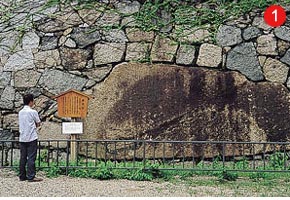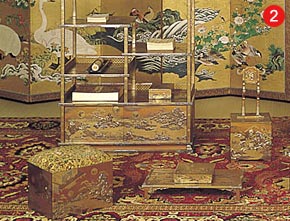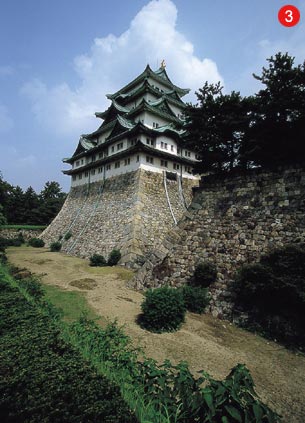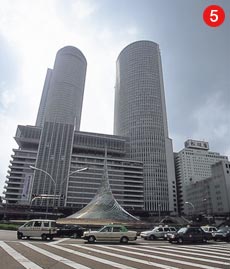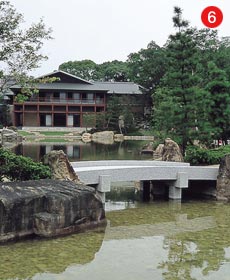| Web Japan > NIPPONIA No.31 > Special Feature* |
|
|
|
NIPPONIA No.31 December 15, 2004
|
|
Special Feature*
In the Vicinity of Expo 2005
Aichi Prefecture, where Expo 2005 will be held, is the most prosperous prefecture in the Chubu Region.
Aichi has a rich and varied natural environment, with tree-covered mountains to the west and northeast, and the Pacific Ocean to the south. Here are tips for touring the busy metropolis of Nagoya and some of the famous beauty spots and historic sites near the Expo sites. Written by Sakata Shuji, Photos by Sugawara Chiyoshi
Other photo credit (Photo (2)): Tokugawa Art Museum
|
|
Nagoya—Where ancient history is alive
Nagoya, the capital of Aichi Prefecture, has a population of about 2.17 million. In the central part of the city, streets are laid out something like a checkerboard, oriented north-south and east-west. Major streets are quite wide. Many companies have their offices near Nagoya Station and in the neighboring Marunouchi and Sakae districts. Some of them, most notably Toyota Motor Corporation, got their start in the prefecture and then developed into global companies. There are shops and eating and drinking establishments in easy-access locations in JR Central Towers and other buildings. Nagoya was Japan's first city to have an underground shopping mall, and today the extensive pedestrian "street" networks near Nagoya Station and under the Sakae district are filled with shops. Nagoya, the only major city in the Tokai Region, is an economic powerhouse ranking not far behind Tokyo and Osaka.
The area figures prominently in Japanese history. Civil wars dragged on during the Warring States period (parts of the 15th and 16th centuries), but the country was reunited under two leaders, Oda Nobunaga and Toyotomi Hideyoshi. This made it possible for their successor, Tokugawa Ieyasu, to establish the Edo Shogunate at the beginning of the 1600s. All three men were born in the area—Nobunaga and Hideyoshi in Owari Province (now the western part of Aichi Prefecture), and Ieyasu in Mikawa Province (eastern Aichi Prefecture). Ieyasu made Edo (Tokyo) the political center of the country. He knew that Nagoya was a strategic point on the Tokaido Highway between Edo and Kyoto, and named one of his sons the lord of Nagoya Castle. This son and his descendants, all members of the Owari Tokugawa family, controlled the city and surrounding region under the national feudal system for the next 260 years.
Nagoya Castle, the headquarters of the family, was built around 1612 under the order of Ieyasu. The region's military leaders were called up to construct one part or another of the castle, so anyone comparing their work would know the extent of their loyalty. The stone defense walls contain many huge boulders with flat surfaces, carefully laid in place, and today we can see how the various leaders tried to outdo each another.
The central feature of any Japanese castle is the tenshukaku (main tower), and Nagoya castle actually has two of them, one five stories tall, the other two. They are situated side by side in the honmaru enclosure, which is in the northwestern part of the castle. Anyone wishing to enter the larger tower had to first pass through the smaller one, then through a fortified, bridge-like corridor. This made it difficult for an enemy to penetrate inside. The roof of the taller tower is decorated with two huge golden shachihoko (mythical creatures also known as "grampus" having a dragon head and a dolphin-like body). They have become icons representing not so much the castle but the city of Nagoya itself.
Works of art and objects used by the Owari Tokugawa lords and family are displayed exclusively at the Tokugawa Art Museum, which takes us into the lives of people in feudal high society in the Edo period (1603-1867). Exhibits include the hatsune no chodo dowry goods for a feudal lord, helmets, armor, swords, and artistic objects that show the cultural side of life, like tea ceremony utensils, calligraphy and pictures. The 4.5-hectare Tokugawaen Garden next to the museum has a large ornamental pond and a good expanse of trees. The land was developed as a private retreat for the second feudal lord, but is now a municipal park open to the public.
|
|
||||||
|
||||||
|
